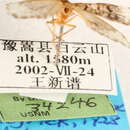Comprehensive Description
provided by Smithsonian Contributions to Zoology
Neopseustis archiphenax Meyrick
Neopseustis archiphenax Meyrick, 1928:404.—Fletcher, 1933: 83—Mutuura, 1971:1129.
ADULT (Figure 15).—Wing expanse: , 26–27 mm.
Head: Largely devoid of scales (badly rubbed) exposing dark fuscous integument. Maxillary and labial palpi similarly sparsely scaled, fuscous.
Thorax: Dorsum mostly naked, dark fuscous, sparsely covered with slender brownish scales. Forewings light brown to stramineous, heavily mottled with various shades of fuscous; basal two-thirds of wing dull white to stramineous, with 3 or 4 rather indistinct fuscous spots along costal cell; a large, slightly curved fuscous spot extending between M2 and CuA1; two triangular fuscous spots situated along hind margin at CuAl and CuA2; a series of smaller, transverse spots scattered over posterior half of wing; a few broad, silvery white scales scattered somewhat randomly over basal two-thirds though concentrated along major veins; outer third of wing whitish, with numerous irregular spots of light brown; a series of mostly confluent spots bordering apex and termen. Hindwings considerably paler; basal two-thirds light grayish brown; outer third whitish with a nearly continuous, broad row of light grayish brown spots bordering outer margin from apex to CuA1.
Abdomen: Thinly covered with slender, hairlike, brownish scales. Seventh sternite of male with a prominent median, conical process bearing 6 minute, closely appressed spines; eighth sternite with low median ridgelike lobe bearing approximately 23 irregular, rather elongate, blunt spines along its caudal margin.
Male genitalia: Gnathos a slender, uncinate process arising between socii and projecting ventrally. Valvae with a small, slender, bilateral pair of clavate lobes arising from base of sacculus and nearly contiguous along midline. Lateroposterior lobes of anellus bilaterally symmetrical, deeply forked near base, giving rise to two elongate, asymmetrical processes; inner branch more stout, roughly serrated along entire length of outer (lateral) edge. Parameres greatly lengthened, surpassing apex of uncus, densely pubescent over ventral half.
TYPE.—Holotype, ; in the British Museum (Natural History).
TYPE-LOCALITY.—Kangtang [?], upper Burma.
DISTRIBUTION (Map 1).—Presently known from upper Burma and Szechuan Province in southwestern China.
MATERIAL EXAMINED.—2 males.
BURMA. Kangtang: I (holotype), coll E. A. Swann (BMNH).
CHINA. Szechuan Province: Sungpan: 1 , July, D. C. Graham coll. (USNM).
- bibliographic citation
- Davis, Donald R. 1975. "Systematics and Zoogeography of the Family Neopseustidae with a proposal of a New Superfamily (Lepidoptera: Neopseustoidea)." Smithsonian Contributions to Zoology. 1-44. https://doi.org/10.5479/si.00810282.210

